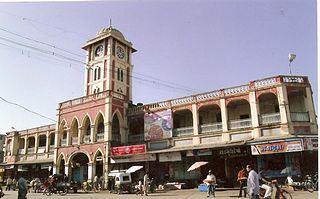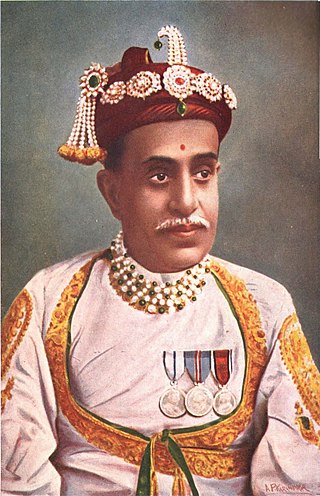
Miraj is a city that is part of the Sangli-Miraj-Kupwad metropolitan region in Sangli district, Maharashtra. Founded in the early 10th century, Miraj was an important jagir of the Bijapur Sultanate.
Kurundwad is a town on the banks of the Panchganga river, 55 km from Kolhapur in the Indian state of Maharashtra.

Miraj Senior was one of two Maratha princely states during the British Raj: 'Miraj Junior' and Miraj Senior. The two states separated in 1820. It was under the southern division of the Bombay Presidency, forming part of the southern Mahratta Jagirs, and later the Deccan States Agency.

Jamakhandi is a city in Bagalkot district in the Indian state of Karnataka. It was the capital of the former princely state of Jamkhandi. It is located 90 km towards west from district headquarters. It is the first princely state to merge in constituent India based on demand to make Jamkhandi as a district. It is a subdivision of the district. Mudhol, Bilagi, Rabakavi-Banahatti, Teradal and Jamakhandi taluks come under Jamakhandi subdivision.

The Kolhapur State was a Maratha princely state of India, under the Deccan Division of the Bombay Presidency, and later the Deccan States Agency. It was considered the most important of the Maratha principalities with the others being Baroda State, Gwalior State and Indore State. Its rulers, of the Bhonsle dynasty, were entitled to a 19-gun salute – thus Kolhapur was also known as a 19-gun state. The state flag was a swallow-tailed saffron pennant.

Jath State, was one of the non-salute Maratha princely states of Deccan States Agency, one of the former Southern Maratha Jagirs. Jath State and Daphlapur State were the only two states belonging to the Bijapur Agency under the Bombay Presidency, which later became part of the Deccan States Agency.

Jamkhandi State was one of the Maratha princely states of British India. It was founded in 1811 and its capital was at Jamakhandi. It was administered as part of the Deccan States Agency of the Bombay Presidency and was one of the former states of the Southern Maratha Country. The area that was under this princely state is part of present day Karnataka.

Aundh State was a Maratha princely state during the British Raj, in the Deccan States Agency division of the Bombay Presidency.

Mudhol State was a princely state during the British Raj. The rulers were from the Ghorpade Dynasty of the Marathas. It was one of the former states of the Southern Maratha Country and its capital was the city of Mudhol in present-day Bagalkote District of Karnataka State in India. The last ruler was HH Shrimant Raja Bhairavsinhrao Malojirao Ghorpade II. Mudhol acceded to the Dominion of India on 8 March 1948, and is currently a part of Karnataka state.

Sangli State was one of the 11-gun salute Maratha princely states of British India. It was under the Kolhapur-Deccan Residency in the Bombay Presidency, and later the Deccan States Agency.

The following list includes a brief about the titles of nobility or orders of chivalry used by the Marathas of India and by the Marathis/Konkanis in general.

Kurundvad Senior, also spelt as 'Kurundwad', was one of two Maratha princely states during the British Raj: 'Kurundvad Junior' and Kurundvad Senior. The two states separated in 1854 and less than a century later, on 8 March 1948, both states acceded to the Indian Union.

Kurundvad Junior, also spelt as 'Kurundwad', was of two Maratha princely states during the British Raj: 'Kurundvad Senior' and Kurundvad Junior. The two states separated in 1854 and less than a century later, on 8 March 1948, both states acceded to the Indian Union.

Raja Sir Raghunathrao Shankarrao GandekarKCIE, KGSJM, KECM, KGCM, DD was the 11th ruler of the princely state of Bhor of British Raj during the reign (1922–1951). During his reign, he implemented many reforms such as abolition of untouchability, freedom of association and introduction of representative government. He signed the accession to the Indian Union on 8 March 1948 which ended the separate existence of Bhor state.

Shrimant Raja Shankarrao Chimnajirao Gandekar, was the 10th ruler of the princely state of Bhor of British Raj during the reign.
Raja Madhavrao Hariharrao Patwardhan KCIE was the 5th Raja of the princely state of Miraj Jr. of British Raj during the reign (1899–1950). He signed the accession to the Indian Union on 8 March 1948 which ended the separate existence of Miraj Junior state.
The Patwardhan princely state was established by the Patwardhan family, ruling several parts of the Maratha Empire from 1733 till 1948, when it acceded to the Dominion of India. At its peak, various branches of the dynasty controlled several Jagirs within the Maratha Empire, and later became protectorate Princely states in British India.















